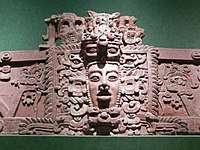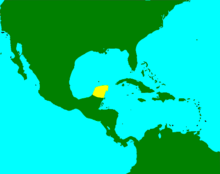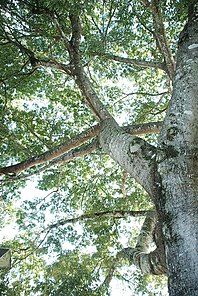Xtabay
La Xtabay is a Yucatec Mayan myth about the female demon, Xtabay, who targets men in the Yucatán Peninsula.[1] She is said to dwell in the forest to lure men to their deaths with her incomparable beauty.[2] She is described as having beautiful, shining black hair that falls down to her ankles and wearing a white dress.[3] One of the most accepted versions of the myth comes from the book, Diez Leyendas Mayas (1998), written by Jesus Azcorra Alejos.[4]
 |
| Maya civilization |
|---|
| History |
| Preclassic Maya |
| Classic Maya collapse |
| Spanish conquest of the Maya |
Etymology
The term "Xtab" was used to refer to an ancient Mayan goddess Ixtab, the goddess of suicide by hanging or the gallows.[5] According to Perez' Lexicon of the Mayan Language, the feminine prefix "tab", "taab", and "tabil" translate to "rope intended for some exclusive use."[5] Ixtab was seen as a benevolent goddess who acted as a psychopomp to whoever hung themselves, leading them to paradise, as suicide was considered an honorable way of dying.[5][6]
The legend of Xtabay
Background

Two equally beautiful women, Xkeban and Utz-colel, lived in a village or pueblo in the Yucatán Peninsula.[7] Sometimes the women are said to be sisters.[8] Xkeban was treated poorly by her community for her promiscuous behavior while Utz-colel was considered virtuous for remaining celibate.[7] The people of the village planned to exile Xkeban, but they decided to allow her to remain in order to further humiliate her. Despite her ill treatment, Xkeban tended to the poor, sick, and animals in need. In contrast to Xkeban, Utz-colel was cold-hearted and believed she was superior to those around her, especially those socially below her.[4] The townspeople adored Utz-colel because of her celibacy and overlooked her cruelty.[4][7]
Several days after Xkeban's death, the townspeople discovered her body surrounded by flowers and being guarded by animals.[7] The homeless and poor who Xkeban helped during her life held a funeral for her and a mysterious, sweet-fragranced flower grew around her grave. Xkeban was transformed to this flower, which is known as a xtabentún, which is a species of morning glory. It has a sweet fragrance and found in hedges, and it was said that flower seeks shelter in the hedges because it is defenseless just as Xkeban felt defenseless when she was a human.[7] This flower is used for a liqueur of the same name.[9]
Utz-colel haughtily believed that her dead body would smell better than Xkeban's because of her purity, however, her dead body had an unbearable smell.[7] The entire pueblo gathered for her funeral, and they put flowers around her grave that disappeared the next day. Utz-colel became a flower called Tzacam, which grows on top of a spiky cactus and has an unpleasant odor.[7] Utz-colel prayed to evil spirits who fulfilled her desire to become a woman again so that she may too become a beautiful flower in death, but she could not feel love due to being motivated by jealously and rage, which lead to her becoming the demon Xtabay.[7]
Modern legend
Xtabay is said to wear a white dress, have large black eyes, and long black hair down to her ankles that she uses to attract men who are out late at night.[10] She waits behind a ceiba tree, a sacred tree in Mayan culture, and is said to comb her hair with the spines of the Tzacam cactus.[4] She lures men deep into the forest, leading to the men to become lost and disoriented before she has sex with them.[10] Once they have sex, Xtabay transforms into a poisonous serpent to devour them.[2] In other versions of the myth, the Xtabay appears in any form or sex that will lure away a person. Xtabay will wait under a tree to lure and then throw her victim over a cliff. Once she throws her victim over a cliff, she then rips out their heart.[2]
An alternative version of the legend, particularly in Quintana Roo, states that Xtabay is the punisher of drunks, thieves, and violent criminals.[11]
Moral of the legend
Despite her promiscuous nature and the resulting ill treatment by her community, Xkeban helped those around her, which ultimately made her worthy of being transformed into the xtabentún flower. In contrast, Utz-colel believed she was virtuous because of her sexual purity and her community’s resulting kind treatment, but she was haughty and unkind to the downtrodden. The moral of the legend is that virtue is within the heart and treatment of those less fortunate, not only in celibacy and actions.[7]
Symbolism
Death
The theme of death is continuous with all of the different versions of the myth of the Xtabay.[10] The fear of death in the myth relies on the capability of the dead to cause harm to the living and the belief that the dead have hostile intentions.[10]
The heart and love
In La Xtabay, the symbolism of the human heart is often repeated throughout the myth, as both Xkeban's and Utz-colel's personalities are described based on the type of "heart" they possessed.[4] Xkeban had a warm heart whereas Utz-colel had a cold heart.[4] Even in death, when Utz-colel wanted to experience life again, she was unable to overcome her envy and loveless heart.[4]
The ceiba tree

The ceiba tree is a sacred tree of the Mayan people since the belief was that a virtuous person could become a ceiba tree after death.[4] The ceiba tree is considered to connect both the heavens and underworld.[4] Xtabay subverts the traditional meaning of the ceiba tree since she hides behind it to lure victims away.[7] It said in the legend that the ceiba roots are where all the men the Xtabay has taken from earth go and that no one has returned from there.[7] It has been suggested that Christian colonialists corrupted the original legend by altering the meaning of the ceiba tree from a sacred tree into a place of danger.[8]
Long black hair
The Xtabay is known for her long black hair falling past her shoulders that she combs with the spines of the tzacam cactus.[4] Mayan culture puts importance on keeping hair long and healthy, however, humid weather and long work days make this difficult, so the working woman's hair is pulled up from the face.[4] Xtabay's hair contrasts the typical hairstyle of Mayan women but represents the culture's ideal of beauty.[4]
Sexuality
Utz-colel was known for her purity because she abstained from sexual relations.[7] In Mayan culture, women are encouraged to be modest and abstain from sexual intercourse until marriage.[4] Women symbolize purity and are taught not to talk to men by themselves.[4] If a Mayan woman does not follow these cultural expectations, she can be condemned for her actions.[4] Xkeban was shamed and humiliated by her community because she did not follow the traditional expectation for woman's behaviour.[7] Xtabay lures men with seduction, which is against the traditional Mayan culture.[4]
Legacy
The legend of Xtabay is part of contemporary Maya culture, as myths influence current beliefs.[4] In the Yucatán peninsula, the word Xtabay illustrates undesirable behavior in women and men, and the legend is used by mothers and grandmother to use the legend to teach good behaviors to their children.[3] The myth also has influence over marriages today, as to prevent infidelity, it is said that Xtabay lures husbands who left their home at night to drink alcohol and seek the attention of other women.[4] The myth is used by parents and grandparents to mold their children into never going out into night to drink or cheat on their wives.[4]
The legend of the Xtabay has influenced music.[12] Les Baxter's album Voice of the Xtabay by Peruvian soprano Yma Sumac depicts the lure of the xtabay in her music.[12]
Similarity to other folktales
There are many similarities to the legend of La Llorona, a ghost who is said to wander Mexico searching for her children and luring away any living children she comes across.[10] Variants of the La Llorona legend are told throughout Mexico and because of the La Llorona figure can be pitied and feared at the same time.[13] Throughout all of the versions, the La Llorona figure is known as "the white lady" because she wears white.[13] Legends similar to La Llorona include La Malinche and La Xtabay.[10][13] La Malinche was said to have three sons by three different men, and she drowned her three lovers, but now is cursed to look for them along the rivers and called to them endlessly.[10] People who look at La Malinche have their necks stuck in the position in which they looked at her and must be cured by a curandero (healer).[10]
References
- Romero, Rolando (2014-05-14). Feminism, Nation and Myth: La Malinche. Arte Publico Press. p. 135. ISBN 9781611920420.
- Starr, Frederick (1904). "Notes upon the ethnography of southern Mexico: expedition of 1901". Proceedings of the Davenport Academy of Sciences. 9: 63–172.
- Preuss, Mary H. (1985). "Vestiges of the Past: The Role of the Grandmother in Contemporary Yucatec Literature". Wicazo Sa Review. 1 (2): 1–10. doi:10.2307/1409116. JSTOR 1409116.
- Romans, Dorothy Jennifer (2013). The siren of syzygy: A textual hermeneutic study of the embrace of the anima/animus in Yucatec Maya culture as seen through the myth of La Xtabay (Thesis). pp. 6, 11, 43–47, 60. ProQuest 1461758952.
- Schellhas, Paul (1910). Representation of Deities of the Maya Manuscripts. The Museum. p. 15.
ixtab.
- Higonnet, Margaret (1985). "Suicide: Representations of the Feminine in the Nineteenth Century". Poetics Today. 6 (1/2): 103. doi:10.2307/1772124.
- Lampi, Leona (1 January 1950). "The influences of some Mexican folklore and beliefs on Mexican life". Cite journal requires
|journal=(help) - Strickland, Amanda (2018-05-01). "The Legend of Xtabay". Yucatan Today. Retrieved 2020-06-25.
- Cantarell, Violeta H. (2015-10-12). "Xtabay: Legend With Aroma". Yucatan Today. Retrieved 2020-06-25.
- Miller, Elaine K. (2014). Mexican Folk Narrative from the Los Angeles Area: Introduction, Notes, and Classification. University of Texas Press. ISBN 978-1-4773-0141-8.
- Green, Joanna (2011-03-25). "The Xtabay, Legendary Mayan Temptress". Royal Resorts. Retrieved 2020-06-25.
- Sloan, Heather (2009). "The Other World Music: Percussion as Purveyor of Cultural Cues in Exotic Lounge Music". College Music Symposium. 49/50: 409–426. JSTOR 41225268.
- Kirtley, Bacil F. (1960). ""La Llorona" and Related Themes". Western Folklore. 19 (3): 155–168. doi:10.2307/1496370. JSTOR 1496370.
Further reading
- Kirtley, Bacil F. (July 1960). "La Llorona" and Related Themes. Western Folklore (Thesis). 19. p. 155. doi:10.2307/1496370.
- Miller, Elaine K. (1973). Mexican Folk Narrative from the Los Angeles Area: Introduction, Notes, and Classification. University of Texas Press. ISBN 978-0-292-74143-0.
- Romero, Rolando; Harris, Amanda Nolacea (2014). Feminism, Nation and Myth: La Malinche. Arte Público Press. ISBN 978-1-61192-042-0. OCLC 1039712483.
- Sloan, Heather (2009). "The Other World Music: Percussion as Purveyor of Cultural Cues in Exotic Lounge Music". College Music Symposium. 49/50: 409–426. JSTOR 41225268.
- Starr, Frederick (1904). Notes upon the ethnography of Southern Mexico. OCLC 254978548.